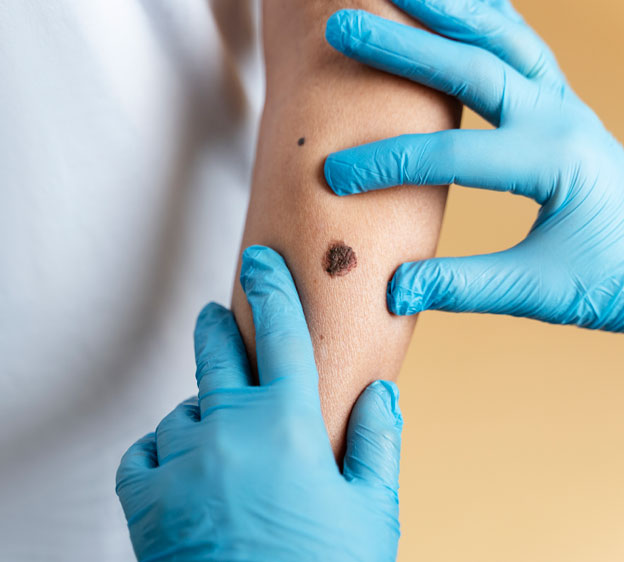
As the most common cancer in America, skin cancer affects 20% of Americans by age 70. Oncologists often use surgery to treat the disease, but surgery can leave scars. In some cases, radiation for skin cancer can kill cancer cells while potentially causing fewer side effects than other forms of treatment.
“We are seeing a growing number of cases of skin cancer in our practice,” says Dr. Jonathan Briggs, a board-certified radiation oncologist at Beaufort Memorial Keyserling Cancer Center in Beaufort. “Radiation therapy is an effective treatment for skin cancer. It is often used in addition to surgery and, for some patients, as the primary skin cancer treatment.”
Determining the Right Skin Cancer Treatment
Treating skin cancer depends heavily on the type you have. There are three primary forms of skin cancer:
- Basal cell carcinoma — The most common skin cancer, basal cell carcinoma often arises on the head, neck and arms after years of tanning or sun exposure. If not treated, it can cause serious damage to nerves and bones.
- Squamous cell carcinoma — Like basal cell carcinoma, this cancer shows up most often in areas that get lots of sun exposure. It, too, can grow deep in the body and spread, if not detected and treated early.
- Melanoma — Melanoma is considered the most dangerous skin cancer and is more likely to spread than basal and squamous cell skin cancers. Moles that indicate melanoma are often asymmetrical, have an irregular border and multiple colors, are bigger than a pencil eraser, and change over time, according to the American Academy of Dermatology.
Read More: Protect Your Skin from Sun Damage
Radiation therapy is often used for nonmelanoma skin cancers that:
- Are advanced and growing
- Are large
- Exist in an area that may be difficult to reach surgically, such as the ears and eyelids
- Have returned after being treated with surgery
- Have spread to nearby organs or lymph nodes
Your cancer care team may also recommend radiation therapy if you are older than age 60 or have health issues that make surgery difficult or risky.
“Surgery and immunotherapy are certainly considered the first-line management for most patients with melanoma,” Dr. Briggs says. “Focused field radiation can be used as the primary treatment for select patients with minimally invasive melanoma lesions. Radiation finds its primary use as a follow-up to surgery, or in patients whose lesions do not respond well to initial therapy. In addition, stereotactic radiation has been found to be effective for select patients whose cancer has spread to the brain. The effectiveness of a combination of radiation with a type of immunotherapy called checkpoint inhibitors, which blocks proteins from binding, is still being studied.”
Although radiation therapy can effectively treat some skin cancers, your doctor may recommend additional treatment with surgery, immunotherapy or targeted therapies. Every patient’s journey is different, and your doctor will make sure to tailor treatment recommendations to your cancer.
Side Effects of Radiation for Skin Cancer
Radiation oncologists treat skin cancer with external beam radiation, in which a machine called a linear accelerator aims a beam of radiation at the tumor. The radiation reaches only the skin, which helps reduce side effects on tissues and bone below the skin. However, side effects can still occur. They may include:
- Blistering, peeling, redness or other skin irritation at the site of radiation
- Digestive issues, such as nausea, vomiting and diarrhea, if the skin cancer is on your stomach or pelvis
- Hair loss on the treated area of the arm, head or other body part
- Oral health issues (in cancers near the mouth), such as tooth damage or injury to glands that produce saliva
- Other changes in skin color where the radiation takes place
Read More: 9 Symptoms to Never Ignore
7 Tips for Skin Care During Treatment
If you’re receiving radiation therapy, your skin may be tender and uncomfortable. Proper skin care can help you feel better, help your skin recover after treatment and possibly reduce additional side effects.
Take the following steps every day you receive radiation and continue them until your skin has fully recovered after your treatments end.
- Avoid washcloths. Washcloths, loofahs and sponges can irritate skin. Use your hands instead.
- Wash daily. Wash yourself every day with warm water. As you clean the affected area, take your time and be gentle. Also, ignore the lines your care team draws on your skin. Those will go away over time, and trying to scrub them away can further irritate skin. Finally, ask your care team if they recommend a specific soap. Pat your skin dry to avoid causing more irritation.
- Don’t shave. If you normally shave the treated area, put that on hold. Shaving can irritate skin and cause a rash.
- Moisturize. Ask your care team about the best moisturizer to use, and apply it as directed, careful to avoid open wounds.
- Be wise with your skin care products. Fragrances can irritate skin, as can nicotine patches and adhesive bandages. It’s also smart to avoid antiperspirant, which can cause you to get a higher dose of radiation.
- Dress for comfort. Loose-fitting clothes are less likely to rub up against sensitive skin. If your skin cancer is on your hands, wear gloves while doing chores, such as washing dishes, to protect your skin.
- Be sun smart. Wear sunscreen before going outside, cover the treated skin and stay in the shade as much as possible.
Read More: The Truth About Sunscreen
Finally, be alert to changes on your skin during and after treatment. Side effects, such as rashes and redness, can be treated but can also appear in the weeks, months and years after receiving radiation. Radiation therapy can also increase the risk of developing another skin cancer in the treated area, so monitor your skin for suspicious spots and moles and show them to your care team as soon as possible. It’s always better to be safe than sorry.
Want to learn more about radiation oncology for skin cancer? Find out how to schedule a consultation or speak with an oncology nurse navigator at Beaufort Memorial.

